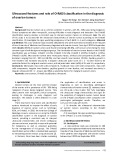
HUE JOURNAL OF MEDICINE AND PHARMACY ISSN 1859-3836 51
Hue Journal of Medicine and Pharmacy, Volume 14, No.2-2024
Ultrasound features and role of O-RADS classification in the diagnosis
of ovarian tumors
Nguyen Thi Trang1, Tran Van Bao1, Dang Cong Thuan1*
(1) Hue University of Medicine and Pharmacy, Hue University
Abstract
Background: Ovarian tumors are a common condition in women, with 5% - 30% cases being malignant.
Clinical symptoms are often nonspecific, causing difficulties in early diagnosis and detection. The O-RADS
classification system provides a consistent way to interpret ovarian masses on ultrasound. Aim: The aim
of this study is to (1) Describe the ultrasound characteristics of ovarian tumors according to the O-RADS
classification. (2) Investigate the signs predicting malignancy in the O-RADS 3, 4, and 5 categories. Materials
and Method: This cross-sectional study involved 188 patients who were examined and treated at the Hospital
of Hue University of Medicine and Pharmacy, diagnosed with ovarian tumors, from April 2022 to September
2023. Results: 88.8% of ovarian tumors were found to be benign (88.8%), with serous tumors being the most
common type in both benign and malignant groups. The distribution of ovarian tumors based on the O-RADS
classification was as follows: O-RADS 1 (1.6%), O-RADS 2 (52.1%), O-RADS 3 (22.9%), O-RADS 4 (17.6%),
O-RADS 5 (5.9%). Most ovarian tumors were monocystic masses, without solid components (65.4%), with
diameters ranging from 50 - 100 mm (58.0%), and had smooth inner borders (79.3%). Papillary growth in
inner borders and increased vascularity in Doppler ultrasound (color score: CS = 2 - 4) were found to be
predictive factors for malignant ovarian tumors, with adjusted odds ratios (aOR) of 8.5 and 5.5, respectively.
Conclusions: Monocystic mass with solid components, multicystic mass with solid components, mass with
solid components, irregular inner borders, papillary growth in inner borders, and increased vascularity in
Doppler ultrasound (CS = 2 - 4) were identified as predictive factors for malignant ovarian tumors.
Keywords: ovary tumors, O-RADS classification, ultrasound.
Corresponding: Dang Cong Thuan, Email: dcthuan@huemed-univ.edu.vn
Recieved: 6/2/2023; Accepted: 19/2/2024; Published: 25/2/2024
DOI: 10.34071/jmp.2024.2.7
1. BACKGROUND
Ovarian tumors are the most common disease
of the ovaries with a prevalence of 5% - 30% being
malignant of cases being malignant lesions. They
often present with nonspecific clinical symptoms,
leading to challenges in early diagnosis and
detection. The disease is often detected in a late
stage [1].
There have been many scores and classification
systems introduced to improve the effect of early
diagnosis of ovarian cancer such as Schillinger,
IOTA, or GI-RADS. In 2018, the American College of
Radiology issued a consensus on using the O-RADS
classification system in the diagnosis of ovarian
tumors, providing a consistent way to interpret
ultrasound characteristics and restrict ambiguous
pictures and errors, especially in cases with potential
for malignancy, as well as proposed guidelines
for the management of risk groups. The O-RADS
classification system offers a standardized approach
to interpreting ovarian masses using ultrasound [2].
In Vietnam, there have been studies evaluating
the application of classifications and scores in
diagnosing as well as describing pathological
characteristics of ovarian tumors [3]. However, there
are still quite a few studies that fully investigate
the ultrasound image characteristics and signs for
the prediction of malignant ovarian tumors based
on the O-RADS classification when compared with
postsurgical pathological results. Therefore, we
carry out this study with 2 aims:
1. To describe the ultrasound characteristics
of ovarian tumors according to the O-RADS
classification.
2. To investigate the signs predicting malignancy
in the O-RADS 3, 4, and 5 categories.
2. MATERIALS AND METHODS
2.1. Participants
- A cross-sectional study was conducted on 188
patients who sought examination and treatment at the
Hospital of Hue University of Medicine and Pharmacy.
These patients were diagnosed with ovarian tumors
between April 2022 and September 2023.






















